Intel 123112960 Intel Wireless Series Peripherals User Manual accessory
Intel Corporation Intel Wireless Series Peripherals accessory
Intel >
User Manual
EXHIBIT C – User Guide
FCC ID EJM123112960
The Intel® Wireless Series Installation Guide for
•Base Station
•Keyboard
•Mouse
•Gamepad
Copyright 1999 - 2000 Intel Corporation.
All rights reserved. Patents pending.
Intel Corporation
5200 NE Elam Young Parkway
Hillsboro OR 97214-6497
Intel Corporation assumes no responsibility
for errors or omissions in this publication,
nor does Intel make any committment to
update the information contained herein.
*Other product and corporate names may
be the trademarks of other companies and
are used only for explanation and to the
owner’s benefit without intent to infringe.
First Edition August 2000 A21065-001

1
1Introducing the
Intel® Wireless Series
Thank you for buying Intel® Wireless Series peripherals for
your computer. This installation guide contains instructions
for setting up the Intel Wireless Series Base Station and Intel
Wireless Series peripherals (sold separately).
Important! Each package includes an installation guide so
be sure to use the latest edition. The edition and publication
date are located in the inside cover of each book.
Minimum system requirements
• Windows* 98 or Windows 98SE
• Available Universal Serial Bus (USB) Port
• CD-ROM or DVD drive
Before you begin
Here are a few important things to remember about setting
up your devices:
• You must install and connect the Intel Wireless
Series Base Station first. Turn to page3 f or
instructions.
• Always install the device software before
attempting to connect the device.
• If you’re setting up an Intel Wireless Series
Keyboard and/or Intel Wireless Series Mouse,
don’t disconnect your PS/2* keyboard and/or PS/2
mouse until you have verified that the wireless
device is properly connected and working. Each
section of the Installation Guide tells you how to
verify the new device and when it is safe to
disconnect the old device.
• Keep your old PS/2 keyboard and mouse as back-
up devices.
Troubleshooting information for connecting and using Intel
Wireless Series peripherals starts on page31.
Keep this
installation guide
for future
reference!
It contains
important
troubleshooting
information.

3
2Setting up the Intel®
Wireless Series Base Station
What’s in this package
Inside the Intel® Wireless Series Base Station Accessory
box, you will find:
• Intel Wireless Series Base Station
• Intel Wireless Series Base Station software
CD-ROM
• Power cord
• Installation Guide
• Information card
Important! Be sure to install the Base Station software
before connecting the Base Station to your computer. For
instructions, turn to page 4 .
Introducing the Intel Wireless Series Base
Station
The Base Station is a 900MHz radio-based device that lets
you connect and use simultaneously up to eight (8) Intel
Wireless Series peripherals with your computer. As you use
Intel Wireless Series peripherals with the Base Station, its
lights show you the current status of your wireless devices.
Connect button
“ready” light
• flashes quickly as
wireless devices
are used
• glows steadily
with proper USB
connection
• flashes slowly
when there is no
USB connection
“low batt” light
flashes when the
batteries in a wireless
device need to be
changed
“connect” light
• flashes slowly when
searching for a
wireless device
• flashes quickly as it
connects a wireless
device
• glows steadily when
one or more wireless
devices are connected
USB cable Power cord

4
C H A P T E R 2 Setting up the Intel® Wireless Series Base Station
Setup at a glance
• Install the Intel Wireless Series Base Station
software.
• Restart your computer, if prompted.
• Connect the Base Station to your computer.
• Verify that the Base Station is connected to your
computer.
Install the Intel® Wireless Series Base Station Soft-
ware
1Put the Intel Wireless Series Base Station CD into
the CD or DVD drive of your computer and wait for
the Setup program to start. This may take several
seconds.
2Follow the on-screen instructions to install the
software.
3To register your product, follow the on-screen
instructions. Registered users periodically receive
information about updates, upgrades, and special
offers.
4At the end of Setup, follow the on-screen instructions
to finish the software installation and connect your
Intel Wireless Series Base Station.
5If prompted, restart your computer.
Where to put the Intel Wireless Series Base Station
You can put the Intel Wireless Series Base Station anywhere
on your desktop. You don’t have to place the Base Station in
clear view of the Intel Wireless Series peripherals connected
to it.
Because the Base Station is a 900 MHz radio-based device,
we recommend that you do not put the Base Station near the
receiving unit for other 900 MHz cordless home appliances,
such as cordless phones, baby monitors, wireless speakers
and wireless headphones.
If you experience interference with your cordless phone or
other cordless device, page 45 has several suggestions for
reducing interference.
If the Setup
program does
not start
automatically
1 Click Start >
Programs >
Windows
Explorer.
2 Click on the
drive with the
CD icon and the
words “Setup.”
3 Double-click
“Setup.exe” and
follow the
on-screen
instructions.

5
Setting up the Intel® Wireless Series Base Station C H A P T E R 2
Connect the Intel® Wireless Series Base Station
Important! Don’t disconnect your PS/2* keyboard or PS/2
mouse until you are instructed to do so later in this book. If
you disconnect these devices too soon, you won’t be able to
successfully connect and use the Intel Wireless Series
Base Station and Intel Wireless Series peripherals.
1Connect the power cord to the back of the Base
Station and plug the power cord into an electrical
outlet.
2With your computer turned on, connect the Base
Station to any USB port on your computer
3On-screen, the Windows* New Hardware Found
wizard takes a few seconds to detect the Base Station.
The wizard may ask to search your Windows CD-
ROM, so have it available.
Important! If the wizard asks to search your Intel
Wireless Series Base Station CD-ROM:
aMake sure the correct version of the Intel
CD-ROM is in the CD or DVD drive of your
computer. If you need to put the CD-ROM in the
drive, wait a few seconds for your computer to
detect the CD-ROM. Click OK.
bIf the Insert Disk dialog box appears, click the
Browse button.
cIn the Open dialog box, select from the Drives
list the drive that contains the Intel CD-ROM.
dDouble-click the folder for your operating
system, such as “Win98,” and click OK.
eClick OK again in the Insert Disk dialog to
proceed through the wizard.
4After the wizard finishes, if the Setup program
started, click Exit and remove the Intel CD-ROM
from the drive.
If the DVD
drawer won’t
open when the
wizard prompts
you for a CD
1 Open Windows
Explorer: click
Start >
Programs >
Windows
Explorer.
2 Right-click the
DVD drive and
click Eject.
If the New
Hardware Found
wizard detects
an “Unknown
Device”
1 Click Cancel to
stop the wizard.
2 If you installed
the Base Station
software, restart
your computer
and proceed
through the
wizard when it
starts.
3 If you didn't
install the Base
Station software,
disconnect the
Base Station,
turn to page4,
and follow the
installation and
connection
instructions.

6
C H A P T E R 2 Setting up the Intel® Wireless Series Base Station
Verify that the Intel Wireless Series Base Station is
Connected
1Open the Intel Wireless Series Control Panel to verify
that the Base Station is properly connected: click
Start > Programs > Intel Wireless Series > Intel
Wireless Series Control Panel.
You should see the Base Station picture in full color
If the picture glows when you point your mouse at it,
the Base Station is properly installed and connected.
Important! If the Base Station doesn’t appear in full
color, if the Base Station shows an alert icon, as
shown below
or if you’re having trouble connecting the Base Sta-
tion, don’t disconnect your old keyboard or mouse
yet, and turn to the Troubleshooting section on
page 31.
Now you’re ready to connect an Intel Wireless Series
peripheral to the Base Station, so turn to the section for the
device(s) that you want to connect:
• Intel Wireless Series Keyboard - turn to page 7 .
• Intel Wireless Series Mouse - turn to pag e15.
• Intel Wireless Series Gamepad - turn to page 23.

7
3Setting up the Intel®
Wireless Series Keyboard
What’s in this package
Inside the Intel® Wireless Series Keyboard Accessory box,
you will find:
• Intel Wireless Series Keyboard
• Intel Wireless Series Keyboard software CD-ROM
• 3 AA disposable alkaline batteries
• Installation Guide
• Information card
Setup at a glance
• Install the Intel Wireless Series Keyboard software.
• Restart your computer, if prompted.
• Insert the batteries into the keyboard.
• Connect the keyboard.
• Verify that the keyboard is connected.
• Disconnect your old keyboard.
Install the Intel Wireless Series Keyboard Software
1Put the Intel Wireless Series Keyboard CD-ROM into
the CD or DVD drive of your computer and wait for
the Setup program to start. This may take several
seconds.
2Follow the on-screen instructions to install the
keyboard software.
3To register your product, follow the on-screen
instructions. Registered users periodically receive
information about updates, upgrades, and special
offers.
4At the end of Setup, follow the on-screen instructions
to finish the software installation and connect your
Intel Wireless Series Keyboard.
5If prompted, restart your computer.
If the Setup
program does
not start
automatically
1 Click Start >
Programs >
Windows
Explorer.
2 Click on the
drive with the
CD icon and the
words “Setup”.
3 Double-click
“Setup.exe” and
follow the
onscreen
instructions.
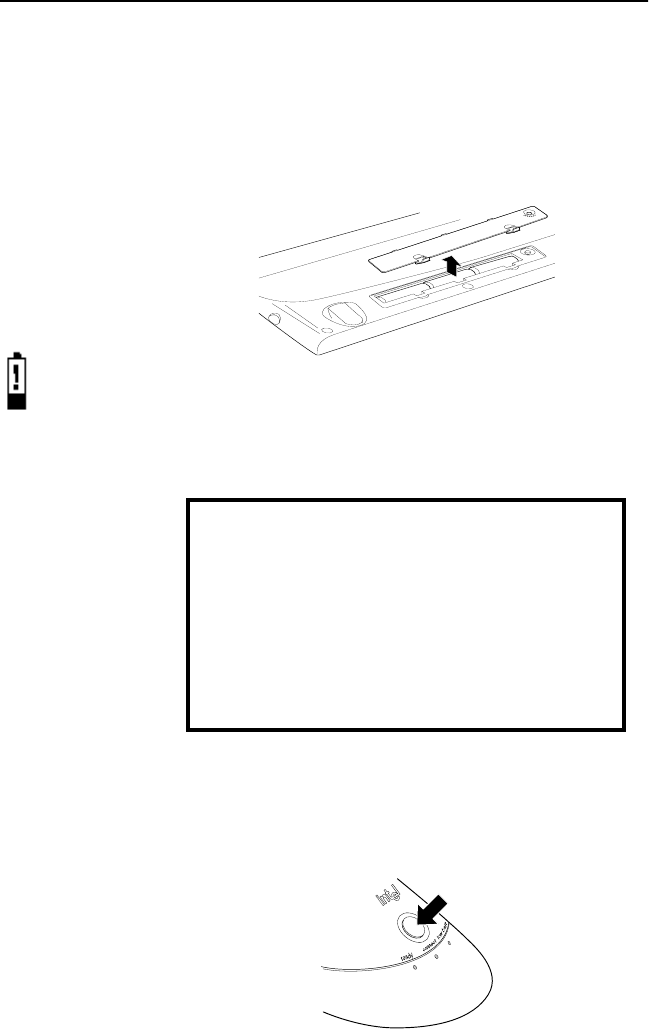
8
C H A P T E R 3 Setting up the Intel® Wireless Series Keyboard
Insert the Batteries into the Intel Wireless Series Key-
board
The keyboard uses 3 AA alkaline batteries. Rechargeable
batteries are not recommended.
1Remove the battery compartment cover from the
bottom of the keyboard.
2Insert the batteries. Make sure that the “+” and “-” on
each battery matches the “+” and “-” on each slot.
3Put the cover on.
Connect the Intel Wireless Series Keyboard
Important! Don’t disconnect your old PS/2* keyboard until
you have verified that the Intel Wireless Series Keyboard is
properly connected to your computer
1Press the connect button on the front of the Base
Station. The “connect” light flashes slowly.
Before you connect the Intel Wireless Series
Keyboard, double-check the following:
1the Intel Wireless Series Base Station is
installed and connected to your computer.
For instructions, see p age7.
2the Intel Wireless Series Keyboard software
is installed and, if prompted, you restarted
your computer
Be patient while
connecting the
keyboard
It may take up to 3
minutes to connec
the keyboard.
Conserving the
batteries
After 2 hours of
inactivity, a
connected
keyboard goes
to sleep.
• To awaken the
keyboard, press
any key.
Low batteries
It’s time to
change the
batteries
when the
battery icon
appears in the
display on the
front of the
keyboard.

9
Setting up the Intel® Wireless Series Keyboard C H A P T E R 3
2Press the connect button on the bottom of the
keyboard.
The “connect” light flashes faster when the Base Sta-
tion detects the keyboard. When the keyboard is con-
nected, the Base Station’s “connect” light stays on
steadily.
3On-screen, the Windows* New Hardware Found
wizard runs briefly after the keyboard connects. The
wizard may ask to search your Windows CD-ROM,
so have it available.
Important! If the wizard asks to search your Intel
Wireless Series Keyboard CD-ROM:
aMake sure the correct version of the Intel
CD-ROM is in the CD or DVD drive of your
computer. If you need to put the CD-ROM in the
drive, wait a few seconds for your computer to
detect the CD-ROM. Click OK.
bIf the Insert Disk dialog box appears, click the
Browse button.
cIn the Open dialog box, select from the Drives
list the drive that contains the Intel CD-ROM.
dDouble-click the folder for your operating
system, such as “Win98,” and click OK.
eClick OK again in the Insert Disk dialog to
proceed through the wizard.
4After the wizard finishes, if the Setup program
started, click Exit and remove the Intel CD-ROM
from the drive.
If the New
Hardware Found
wizard detects an
“Unknown
Device”
1 Click Cancel to
stop the wizard.
2 If you installed
the keyboard
software, restart
your computer
and proceed
through the
wizard when it
starts.
3 If you didn't
install the
keyboard
software, turn to
page 7 and
follow the
installation and
connection
instructions.
If the DVD
drawer won’t
open when the
wizard prompts
you for a CD
1 Open Windows
Explorer: click
Start >
Programs >
Windows
Explorer.
2 Right-click the
DVD drive and
click Eject.
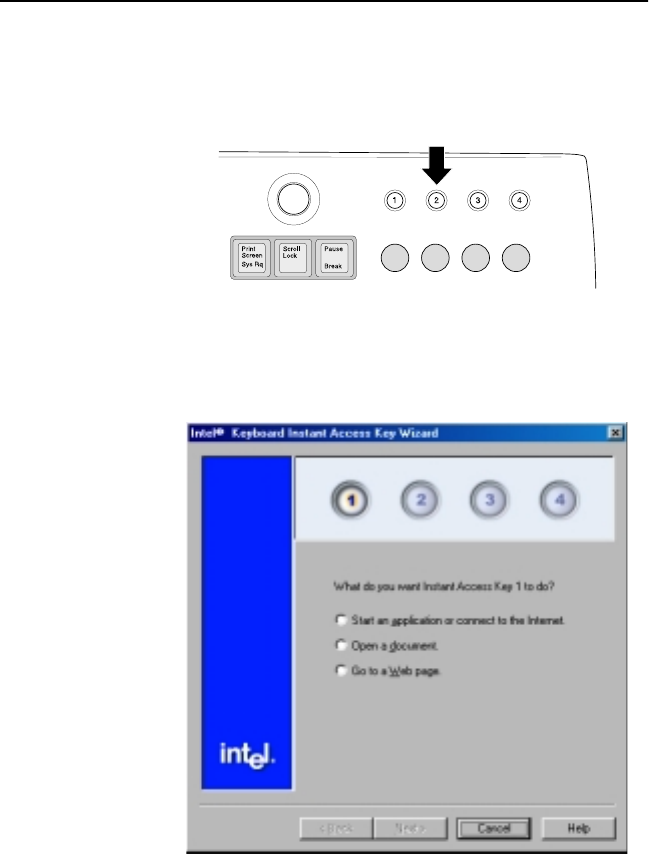
10
C H A P T E R 3 Setting up the Intel® Wireless Series Keyboard
Verify that the Intel Wireless Series Keyboard is Con-
nected
1Press one of the Instant Access Keys, located on the
upper right side of the keyboard:
2If the Instant Access Keys wizard starts, as shown
below, the keyboard is properly installed and
connected. Click Exit to close the Instant Access
Keys wizard. You can configure these later.
Important! If the Instant Access Keys wizard didn’t
start or you’re having trouble connecting the key-
board, don’t disconnect your old keyboard yet and
turn to the Troubleshooting secti on on page31.
Keep your old
PS/2 keyboard
After you have
successfully
installed and
connected your
Intel Wireless
Series Keyboard,
keep your PS/2
keyboard as a
back-up.

11
Setting up the Intel® Wireless Series Keyboard C H A P T E R 3
After you have verified that the keyboard is connected,
you’re ready to disconnect your old PS/2 keyboard:
1If the keyboard is properly connected, shut down
Windows: click Start > Shut Down, click “Shut
Down” and then click OK.
2Turn off your computer.
3Disconnect your old keyboard and turn on your
computer
Now you’re ready to use your new Intel Wireless Series
Keyboard. For a brief summary of its features and
configuration instructions, turn to p age12.
If have another Intel Wireless Series peripheral to connect,
turn to the appropriate section of this book:
• Intel Wireless Series Mouse - turn to page15.
• Intel Wireless Series Gamepad - turn to page 23.
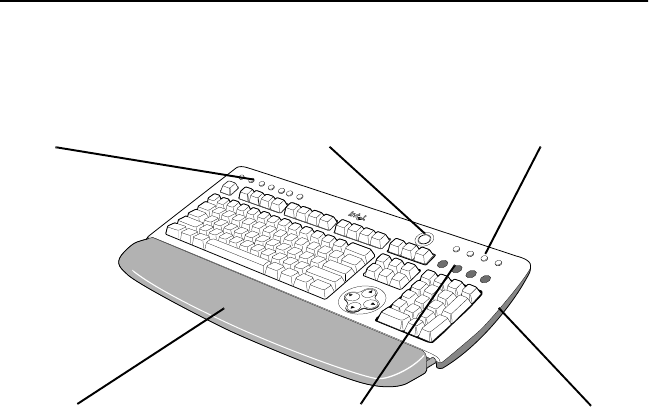
12
C H A P T E R 3 Setting up the Intel® Wireless Series Keyboard
Using the Intel
Wireless Series Keyboard
The Intel Wireless Series Keyboard has several sets of
special keys to make it easier to use frequently used files,
programs and settings on your computer. There’s also a
folding palm rest to support your wrists when you take a
break from typing. For more information, check the online
Help: click Start > Programs > Intel Wireless Series >
Help.
Using the Instant Access Keys
You can configure each of the four Instant Access Keys to
open a file, start a program, start your Internet connection or
open a Web page.
1Click the Start > Settings > Control Panel and
double click the Keyboard icon.
2In the Keyboard Properties dialog box, click the
Instant Access Keys tab.
3To configure an Instant Access Keys click the Assign
button next to the key.
4Follow the on-screen instructions in the Instant
Access Keys wizard.
5Click Finish to close the wizard.
CD Player Keys
control the Windows*
CD Player and system
volume
Instant Access Keys
4 keys for opening files,
programs, or your Internet
connection
Palm Rest
folds under the keyboard
for easy storage
Control Panel Key
opens the Intel® control panel
for managing Intel peripherals
Keyboard Display
shows when Num Lock,
Caps Lock, Scroll Lock are
turned on and Low Battery
indicator
Palm Rest Release
press the button on each
side to unfold the palm rest

13
Setting up the Intel® Wireless Series Keyboard C H A P T E R 3
Using the CD Player Keys
Your Intel Wireless Series Keyboard includes keys that let
you control the Windows CD Player on your computer. By
default, the CD Player Key actions appear on the screen
when you press a CD Player Key on your keyboard. For
example, if you press the Play key on your keyboard, the
word “Play” appears on your screen and disappears after a
few seconds. You can modify the appearance of the on-
screen actions or turn them off if you don’t want to see them.
To modify the on-screen appearance of the CD Player
Keys actions
1Click the Start > Settings > Control Panel and
double click the Keyboard icon.
2In the Keyboard Properties dialog box, click the CD
Player Keys tab.
3Click the Font button to open the Font dialog box.
Change the font’s type, size and/or color, and then
click OK.
4If you change your mind and want to use the original
Intel settings on a tab, click the tab’s Use Defaults
button.
5To close the Keyboard Properties and save your
settings, click OK.
6To close the Keyboard Properties without saving any
changes, click Cancel.
To turn off the display of CD Player Key actions
1Click the Start > Settings > Control Panel and
double click the Keyboard icon.
2In the Keyboard Properties dialog box, click the CD
Player Keys tab.
3Clear the Show CD Player Key actions on-screen
check box.
4If you change your mind and want to use the original
Intel settings on a tab, click the tab’s Use Defaults
button.
5To close the Keyboard Properties and save your
settings, click OK.
6To close the Keyboard Properties without saving any
changes, click Cancel.

14
C H A P T E R 3 Setting up the Intel® Wireless Series Keyboard
Using the Palm Rest
The palm rest folds under the keyboard for easy storage. To
use the palm rest, press the blue button on each side of the
Intel Wireless Series Keyboard and lift up the palm rest.
When you want to put the palm rest away, fold the palm rest
under the keyboard making sure the palm rest support is flat
against the palm rest before you press the palm rest firmly
into place. If you need to replace the palm rest support,
attach it to the palm rest with the smooth side against the
palm rest.
Safe Usage Suggestions
Caution! Although the data are inconclusive, some
experts believe that using a keyboard in certain ways (e.g.
excessive keying forces, poor posture, improper workstation
set up, and/or repetitive, extended typing) may be associated
with some forms of acute sprains/strains or chronic upper
extremity musculoskeletal disorders. If at any time you
experience pain, soreness, numbness, tingling, throbbing,
aching, stiffness, weakness or a burning sensation in your
hands, wrists, arms, shoulders, neck or back, promptly
consult a qualified health professional. Do not ignore these
warning signs; they may indicate the presence of a
serious medical condition.
To increase your comfort and minimize the potential for
injury when using a keyboard, follow these guidelines:
• Place the keyboard within comfortable reach;
avoid over-extending to reach the keyboard.
• Adjust your position relative to the keyboard so
that your wrists and forearms are straight and
parallel to the floor. This may mean adjusting your
chair, your computer table or desk (if adjustable),
and, if you use one, your keyboard tray.
• When you type, keep your wrists straight and avoid
placing them on the palm rest pad. Use the palm
rest to rest your hands only when you aren't typing.
• Take frequent breaks from using the keyboard, at
least once per hour.
• Vary your tasks throughout the day.
Ergonomics on the
Web
Visit http://
www.intel.com/
wireless_series for
more information.

15
4Setting up the Intel®
Wireless Series Mouse
What’s in this package
Inside the Intel® Wireless Series Mouse Accessory box, you
will find:
• Intel Wireless Series Mouse
• Intel Wireless Series Mouse software CD-ROM
• 3 AAA disposable alkaline batteries
• Installation Guide
• Information card
Setup at a glance
• Install the Intel Wireless Series Mouse software.
• Restart your computer, if prompted.
• Insert the batteries into the mouse.
• Connect the mouse.
• Verify that the mouse is connected.
• Disconnect your old mouse.
Install the Intel Wireless Series Mouse Software
1Put the Intel Wireless Series Mouse CD into the CD
or DVD drive of your computer and wait for the
Setup program to start. This may take several
seconds.
2Follow the on-screen instructions to install the mouse
software.
3To register your product, follow the on-screen
instructions. Registered users periodically receive
information about updates, upgrades, and special
offers.
4At the end of Setup, follow the on-screen instructions
to finish the software installation and connect your
Intel Wireless Series Mouse.
5If prompted, restart your computer.
If the Setup pro-
gram does not
start automati-
cally
1 Click Start >
Programs >
Windows
Explorer.
2 Click on the
drive with the
CD icon and the
words “Setup.”
3 Double-click
“Setup.exe” and
follow the
on-screen
instructions.
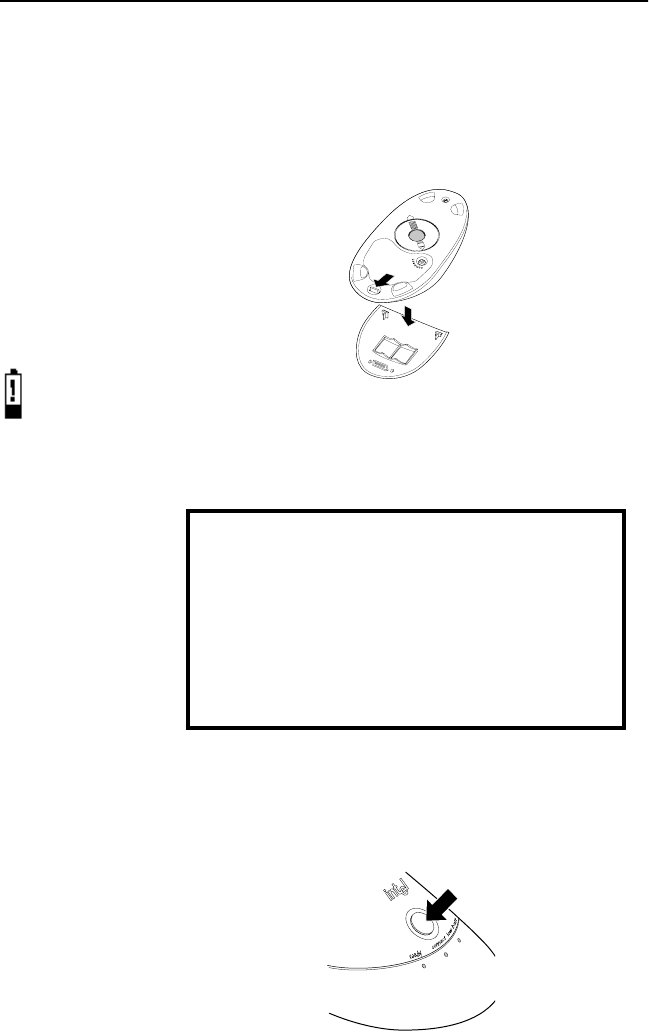
16
C H A P T E R 4 Setting up the Intel® Wireless Series Mouse
Insert the Batteries into the Intel® Wireless Series
Mouse
The mouse uses 3 AAA alkaline batteries. Rechargeable
batteries are not recommended.
1Remove the battery compartment cover as shown
below:
2Insert the batteries. Make sure that the “+” and “-” on
each battery matches the “+” and “-” on each slot.
3Put the cover on.
Connect the Intel® Wireless Series Mouse
Important! Don’t disconnect your old PS/2* mouse until
you have completed this section and confirmed that the Intel
Wireless Series Mouse is connected to your computer.
1Press the connect button on the front of the Base
Station. The “connect” light flashes slowly.
Before you connect the Intel® Wireless Series
Mouse, double-check the following:
1the Intel Wireless Series Base Station is
installed and connected to your computer.
For instructions, see p age4.
2the Intel Wireless Series Mouse software is
installed and, if prompted, you restarted
your computer
Be patient while
connecting the
mouse
It may take up to 3
minutes to connect
the mouse.
Conserving the
batteries
After 20 minutes
of inactivity, a
connected mouse
goes to sleep.
• To awaken the
mouse, press
any button.
Low batteries
It’s time to
change the
batteries
when the
low battery icon
appears near the
mouse picture in
the Intel Wireless
Series Control
Panel: click Start
> Programs >
Intel Wireless
Series > Intel
Wireless Series
Control Panel.

17
Setting up the Intel® Wireless Series Mouse C H A P T E R 4
2Press the connect button on the bottom of the mouse.
The “connect” light flashes faster when the Base Sta-
tion detects the mouse. When the mouse is connected,
the Base Station’s “connect” light stays on steadily.
3On-screen, the Windows* New Hardware Found
wizard runs briefly after the mouse connects. The
wizard may ask to search your Windows CD-ROM,
so have it available.
Important! If the wizard asks to search your Intel
Wireless Series Mouse CD-ROM:
aMake sure the correct version of the Intel
CD-ROM is in the CD or DVD drive of your
computer. If you need to put the CD-ROM in the
drive, wait a few seconds for your computer to
detect the CD-ROM. Click OK.
bIf the Insert Disk dialog box appears, click the
Browse button.
cIn the Open dialog box, select from the Drives
list the drive that contains the Intel CD-ROM.
dDouble-click the folder for your operating
system, such as “Win98,” and click OK.
eClick OK again in the Insert Disk dialog to
proceed through the wizard.
4After the wizard finishes, if the Setup program
started, click Exit and remove the Intel CD-ROM
from the drive.
If the New
Hardware Found
wizard detects an
“Unknown
Device”
1 Click Cancel to
stop the wizard.
2 If you installed
the mouse
software, restart
your computer
and proceed
through the
wizard when it
starts.
3 If you didn't
install the mouse
software, turn to
page 15 and
follow the
installation and
connection
instructions.
If your DVD
drawer won’t
open
1 Open Windows
Explorer: click
Start >
Programs >
Windows
Explorer.
2 Right-click the
DVD drive and
click Eject.
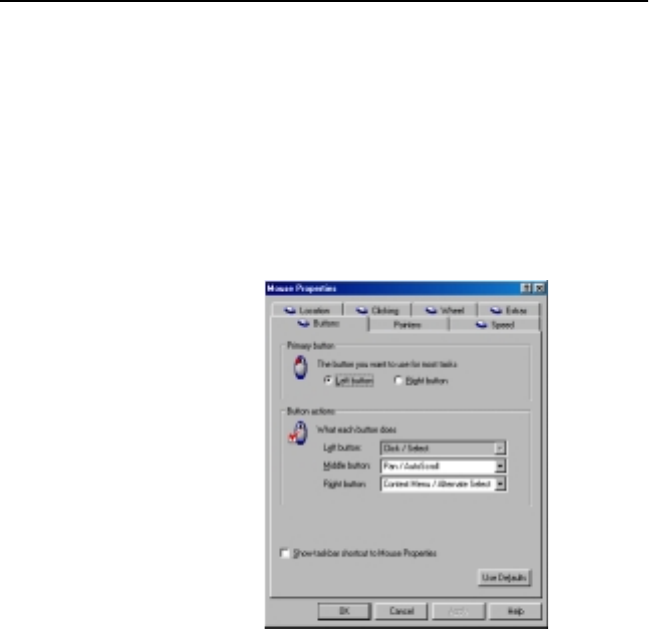
18
C H A P T E R 4 Setting up the Intel® Wireless Series Mouse
Verify that the Intel Wireless Series Mouse is Con-
nected
1Open the Intel Wireless Series Control Panel: click
Start > Programs > Intel Wireless Series > Intel
Wireless Series Control Panel.
2You should see the picture of the mouse in full color
Click the mouse picture and select Configure Device
from the menu. If the Mouse Properties dialog box
appears, as shown below, the mouse is properly
installed and connected:
Important! If you don’t see all the tabs in the Mouse
Properties or you’re having trouble connecting the
mouse, don’t disconnect your old mouse yet, and turn
to the Troubleshooting secti on on page31.
3If the mouse is properly connected, shut down
Windows: click Start > Shut Down, click “Shut
Down” and then click OK. Turn off your computer
4Disconnect your old mouse and turn on your
computer.
Now you are ready to use your Intel Wireless Series Mouse.
To customize the mouse, turn to pa ge19. If have another
Intel Wireless Series peripheral to connect, turn the
appropriate section of this book:
• Intel Wireless Series Keyboard - turn to page 7 .
• Intel Wireless Series Gamepad - turn to page 23.
Keep your old
PS/2 mouse
After you have
successfully
installed and
connected your
Intel Wireless
Series Mouse,
keep your PS/2
mouse as a back-
up.

19
Setting up the Intel® Wireless Series Mouse C H A P T E R 4
Using your Intel
Wireless Series Mouse
The Intel® Wireless Series Mouse has several settings that
you can customize to make it easier to use your computer.
You can customize its buttons and scrolling wheel, track
your mouse usage, and set break time reminders.
These instructions show you how to change some of the
more commonly used features of the mouse. For
information about customizing other mouse features, check
the online Help: click Start > Programs > Intel Wireless
Series > Help.
To customize the mouse buttons
1Click the Start > Settings > Control Panel and
double click the Mouse icon.
2In the Mouse Properties dialog, click the Buttons tab
and change the Primary Mouse Button settings and
action for each button and the scroll wheel.
3If you change your mind and want to use the original
Intel settings on a tab, click the Use Defaults button.
4To close the Mouse Properties and save your settings,
click OK.
5To close the Mouse Properties without saving your
changes, click Cancel.
To customize the mouse wheel
1Click the Start > Settings > Control Panel and
double click the Mouse icon.
2In the Mouse Properties dialog, click the Wheel tab
and change the Scrolling Speed, Pan/Auto-scroll
Speed and Universal Scrolling settings.
3If you change your mind and want to use the original
Intel settings, click the Use Defaults button.
4To close the Mouse Properties and save your settings,
click OK.
5To close the Mouse Properties without saving your
changes, click Cancel.
To set a reminder to take a break
1Click the Start > Settings > Control Panel and
double click the Mouse icon.

20
C H A P T E R 4 Setting up the Intel® Wireless Series Mouse
2On the Extras tab in the Break time section:
• To set a reminder to take a break after a certain
amount of time, select the Elapsed minutes check
box, and then type the number of minutes (10 to
120 minutes) to wait before reminding you to take
a break.
• To set a reminder to take a break after a certain
number keystrokes, select the Keystrokes check
box, and then type the number of keystrokes (1,000
to 20,000 keystrokes) to wait before reminding you
to take a break.
• To set a reminder to take a break after a specified
number of clicks, select the Button clicks check
box, and then type the number of clicks (100 to
2000) to wait before reminding you to take a break.
• To cancel the reminder when you haven’t used
your computer for a certain amount of time, type
the number of minutes in the Cancel reminder if
idle for check box.
3If you change your mind and want to use the original
Intel settings, click the Use Defaults button.
4To close the Mouse Properties and save your settings,
click OK.
5To close the Mouse Properties without saving your
changes, click Cancel.
Safe Usage Suggestions
Caution! Although the data are inconclusive, some
experts believe that using a computer in certain ways (e.g.,
excessive keying forces, poor posture) may be associated
with some forms of acute sprains/strains or chronic upper
extremity musculoskeletal disorders.
If at any time you experience pain, soreness, numbness,
tingling, throbbing, aching, stiffness, weakness or a burning
sensation in your hands, wrists, arms, shoulders, neck or
back, promptly consult a qualified health professional.
Do not ignore these warning signs; they may indicate the
presence of a serious medical condition.

21
Setting up the Intel® Wireless Series Mouse C H A P T E R 4
To increase your comfort and minimize the potential for
injury when using a mouse, follow these guidelines:
• Use a mouse pad with wrist support, which will
cushion and support your wrists
• Minimize repetitive actions by assigning mouse
buttons to the features you use frequently. See
Windows* Help for more information about
configuring the mouse buttons.
• Assign the mouse pointer speed and acceleration,
as well as the double-click speed, so that they are
comfortable.
• Set a reminder to take a break after a certain period
of time, number of keystrokes or clicks.
• Customize the mouse pointer so it moves to a
specific position each time you open a new
window or after a certain amount of inactivity.
• Use the Intel Wired Control Panel to quickly open
the property pages for all Intel Wired peripherals.
Safety Warning for Parents of Small Children
/!\ WARNING:
CHOKING HAZARD - all standard mice, including this
one, have a small ball inside. Not for use by children under 3
years of age.
Keep mouse away from children. When removing the
mouse ball to clean the mouse or for any reason, do not let
children put the mouse ball in their mouths!! Children could
choke on the mouse ball, resulting in serious injury or death.
Ergonomics on the
Web
Visit http://
www.intel.com/
wireless_series for
more information.

23
5Setting up the Intel®
Wireless Series Gamepad
What’s in this package
Inside the Intel Wireless Series Gamepad Accessory box,
you will find:
• Intel Wireless Series Gamepad
• Intel Wireless Series Gamepad software CD-ROM
• 3 AAA disposable alkaline batteries
• Installation Guide
• Information card
Setup at a glance
• Install the Intel Wireless Series Gamepad software.
• Restart your computer, if prompted.
• Insert the batteries into the gamepad.
• Connect the gamepad.
• Verify that the gamepad is connected.
Install the Intel Wireless Series Gamepad Software
1Put the Intel Wireless Series Gamepad CD into the
CD or DVD drive of your computer and wait for the
Setup program to start. This may take several
seconds.
2Follow the on-screen instructions to install the
gamepad software.
3To register your product, follow the on-screen
instructions. Registered users periodically receive
information about updates, upgrades, and special
offers.
4At the end of Setup, follow the on-screen instructions
to finish the software installation and connect your
gamepad.
5If prompted, restart your computer.
If the Setup pro-
gram does not
start automati-
cally
1 Click Start >
Programs >
Windows
Explorer.
2 Click on the
drive with the
CD icon and the
words “Setup.”
3 Double-click
“Setup.exe” and
follow the
on-screen
instructions.
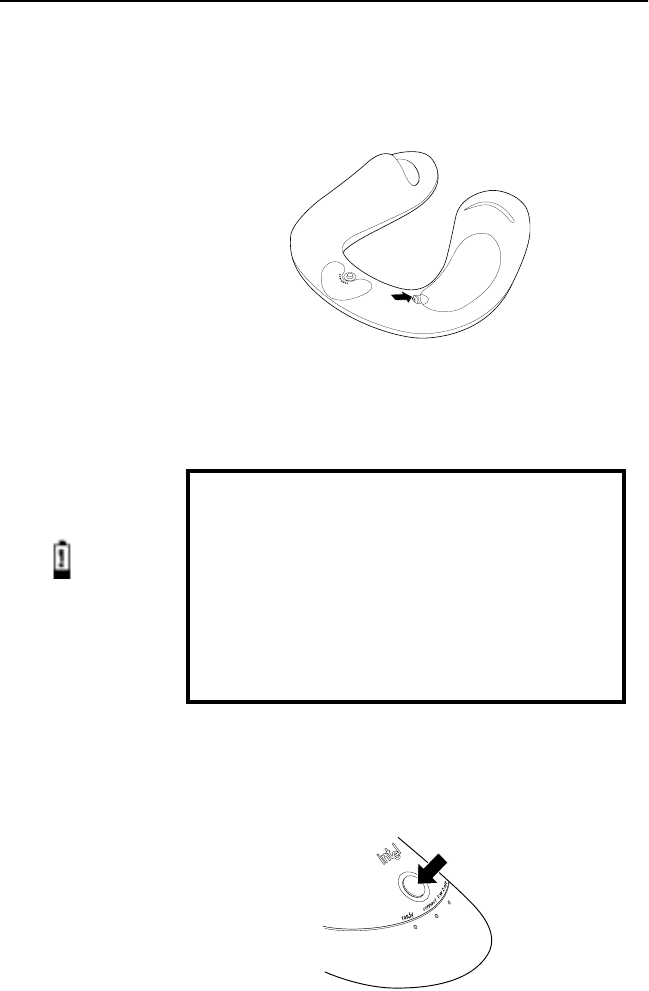
24
C H A P T E R 5 Setting up the Intel® Wireless Series Gamepad
Insert the Intel Wireless Series Gamepad Batteries
The gamepad uses 3 AAA alkaline batteries. Rechargeable
batteries are not recommended.
1Remove the battery compartment cover, as shown:
2Insert the batteries. Make sure that the “+” and “-” on
each battery matches the “+” and “-” on each slot.
3Put the cover on.
Connect the Intel Wireless Series Gamepad
Important! Be patient while connecting the gamepad. It
may take up to 3 minutes to connect the gamepad.
1Press the connect button on the front of the Base
Station. The “connect” light flashes slowly.
Before you connect the Intel Wireless Series
Gamepad, double-check the following:
1the Intel Wireless Series Base Station is
installed and connected to your computer.
For instructions, turn to pa ge3.
2the Intel Wireless Series Gamepad software
is installed and, if prompted, you restarted
your computer
Conserving the
batteries
After 15 minutes
of inactivity, a
connected
gamepad goes to
sleep.
• To awaken the
gamepad, press
any button.
• When the
device number
appears on the
gamepad's
display, the
gamepad is
awake and
ready to play.
• It’s time to
change the
batteries when
the battery icon
appears on the
gamepad’s
display.
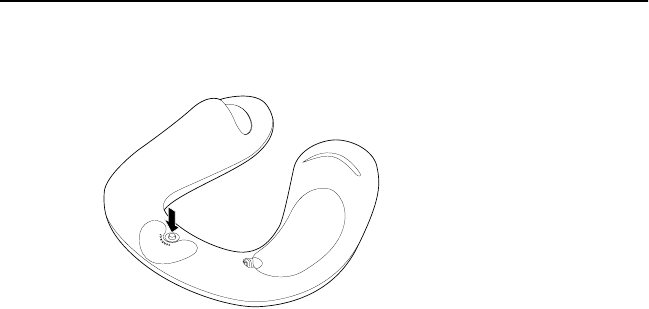
25
Setting up the Intel® Wireless Series Gamepad C H A P T E R 5
2Press the connect button on the bottom of the
gamepad.
The “connect” light flashes faster when the Base Sta-
tion detects the gamepad. When the gamepad is con-
nected, the Base Station’s “connect” light stays on
steadily.
3On-screen, the Windows* New Hardware Found
wizard runs briefly after the gamepad connects. The
wizard may ask to search your Windows CD-ROM,
so have it available.
Important! If the wizard asks to search your Intel
Wireless Series Gamepad CD-ROM:
aMake sure the correct version of the Intel
CD-ROM is in the CD or DVD drive of your
computer. If you need to put the CD-ROM in the
drive, wait a few seconds for your computer to
detect the CD-ROM. Click OK.
bIf the Insert Disk dialog box appears, click the
Browse button.
cIn the Open dialog box, select from the Drives
list the drive that contains the Intel CD-ROM.
dDouble-click the folder for your operating
system, such as “Win98,” and click OK.
eClick OK again in the Insert Disk dialog to
proceed through the wizard.
4After the wizard finishes, if the Setup program
started, click Exit and remove the Intel CD-ROM
from the drive.
If the New
Hardware Found
wizard detects an
“Unknown
Device”
1 Click Cancel to
stop the wizard.
2 If you installed
the gamepad
software, restart
your computer
and proceed
through the
wizard when it
starts.
3 If you didn't
install the
gamepad
software, turn to
page 23 and
follow the
installation and
connection
instructions.
If the DVD
drawer won’t
open when the
wizard prompts
you for a CD
1 Open Windows
Explorer: click
Start >
Programs >
Windows
Explorer.
2 Right-click the
DVD drive and
click Eject.

26
C H A P T E R 5 Setting up the Intel® Wireless Series Gamepad
Verify that the Intel Wireless Series Gamepad is
Connected
1On the gamepad display, you should see the number
“1” (or, if this is a second or third gamepad connected
to the Base Station, “2” or “3”), such as:
2You can also check the Intel Wireless Series Control
Panel: click Start > Programs > Intel Wireless
Series > Intel Wireless Series Control Panel. You
should a picture of the gamepad in full color.
Important! If you don’t see the gamepad number or
the full color picture in the control panel or you’re
having trouble connecting the gamepad, turn to the
Troubleshooting section on page 31.
Now you are ready to use your new Intel Wireless Series
Gamepad. For a brief summary of its features and software,
turn to pag e27.
If you have another Intel Wireless Series peripheral to
connect, turn to the appropriate section of this book:
• Intel Wireless Series Keyboard - turn to page 7 .
• Intel Wireless Series Mouse - turn to pag e15.
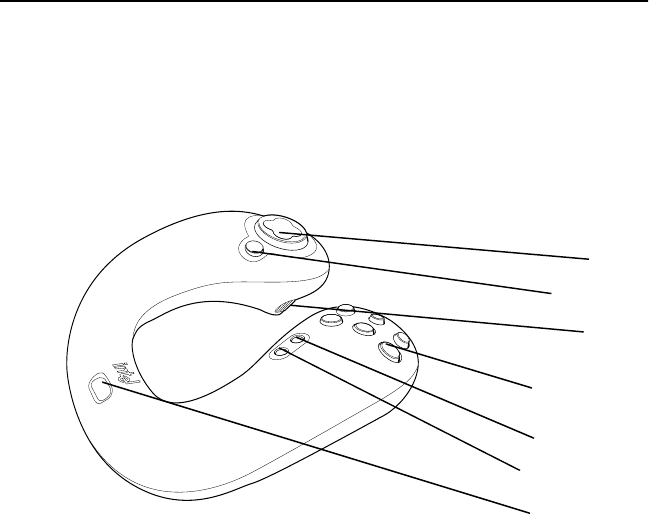
27
Setting up the Intel® Wireless Series Gamepad C H A P T E R 5
Using the Intel Wireless Series Gamepad
This is a brief overview of the basic features and software
for the Intel Wireless Series Gamepad. For detailed
discussion, instructions and solutions to common problems:
click Start > Programs > Intel Wireless Series > Help.
The gamepad has the following buttons and controls:
D-Pad Controls forward, backward, sideways and diagonal
movement as you play a game.
Shift button Supports alternate actions for the 6 action
buttons.
Triggers There is a trigger on the end of each handle.
Action buttons Six buttons to control the main actions in a
game.
“Start” button Push once to start a game.
“Mouse” button Push to start and stop the gamepad's
Mouse Mode, which lets you use the gamepad as a mouse.
Display screen Displays the following icons and numbers
representing important gamepad information:
1, 2, 3, 4, 5, 6, 7, 8 When one or more gamepads
are connected to the Base Station, the display shows
the number identifying each gamepad. This number
is also displayed in the Intel Wireless Series Control
Panel and the Intel Game Profile Activator, so you
can activate a profile for a specific gamepad.
D-Pad
Action buttons
“Start” button
“Mouse” button
Shift button
Display Screen
Triggers

28
C H A P T E R 5 Setting up the Intel® Wireless Series Gamepad
The mouse icon indicates that the gamepad is
currently in Mouse Mode.When Mouse Mode
is turned off, the Mouse symbol is not displayed.
The battery icon indicates that the batteries in
the gamepad need to be changed. When the bat-
tery symbol appears, the batteries have one to
several days of usage remaining. We recommend that
you change the gamepad's batteries promptly
The dash indicates that the gamepad is on, but
not connected to the Intel Wireless Series Base
Station or the gamepad is too far away from the Base
Station.
Using Mouse Mode
The gamepad can work as a mouse for any program on your
computer, in addition to playing games. To start Mouse
Mode, press the “mouse” button on the gamepad. Mouse
Mode has the following default settings:
• Start and stop Mouse Mode by pressing the
“Mouse” button on the gamepad.
• The left mouse button defaults to Button A.
• The middle mouse button (pressing down on the
scroll wheel) defaults to Button B.
• The right mouse button defaults to Button C.
You can customize the Mouse Mode settings by assigning
mouse buttons and functions to the gamepad's buttons and
use the D-Pad to move the mouse pointer. For more
information about using Mouse Mode, check the online
Help: Start > Programs > Intel Wireless Series > Help.
Using Profiles with the Intel Wireless Series
Gamepad
Profiles, a great way to extend your gaming experience, are
files that contain gamepad settings which define actions for
a game. By using profiles, you can customize the actions
that take place when you click the D-Pad, buttons, and
triggers. For example, you can create a profile that includes
all the keyboard and mouse clicks for your favorite game.
When you play a game and activate this profile, your
gamepad takes the place of your keyboard and mouse.
Your regular
mouse still works
when you use
Mouse Mode

29
Setting up the Intel® Wireless Series Gamepad C H A P T E R 5
The gamepad software includes profiles for 50 popular
games and you can download profiles from the Intel Profile
Exchange Web site. You can access the Profile Exchange
from the Intel Game Profile Editor and Intel Game Profile
Activator.
Intel Game Profile Editor
Use the Intel Game Profile Editor to create and manage
profiles for the Intel Wireless Series Gamepad. With the
Profile Editor, you can:
• record game actions
• assign keystrokes and macros to gamepad buttons
• copy or cut and paste actions from one profile to
another profile between profiles
• restore a button's default action, as defined by the
game
• create macros for diagonal movement
• view a list of all keystrokes and macros in a profile
• activate a profile after you create or edit it
• enable and configure Mouse Mode for a profile
You can also open the Intel Profile Exchange Web site,
where you can download new gamepad profiles and upload
your gamepad profiles to share them with other gamepad
users.
Intel Game Profile Activator
Use the Intel Game Profile Activator to activate a profile
and turn off a profile for each connected gamepad. You can
activate the same profile or a different profile for each
connected gamepad. Profiles are files which contain
gamepad settings that define actions in a game.
The Profile Activator also shows basic information about
each connected gamepad, such as whether it is using a
profile. If you want to edit an active profile, view the actions
in an active profile, or create a new profile, you can open the
Intel Game Profile Editor directly from the Activator. There
are also links that open the Intel Wireless Series Control
Panel and the Windows* Game Controllers control panel.
To open the
Profile Editor
• Click Start >
Programs >
Intel Wireless
Series > Intel
Game Profile
Editor
To open th
Profile Activator
• click Start >
Programs >
Intel Wireless
Series > Intel
Game Profile
Activator
Getting to the
Profile Exchange
on the Web
1 In the Profile
Editor or Profile
Activator, click
the globe icon.
2 Select
Download New
Profiles.
3 Follow the on-
screen
instructions.

30
C H A P T E R 5 Setting up the Intel® Wireless Series Gamepad
Safe Usage Suggestions
Caution! Although the data are inconclusive, some
experts believe that using electronic devices in certain ways
(e.g. excessive keying forces, poor posture, improper
workstation set up, and/or repetitive, extended typing) may
be associated with some forms of acute sprains/strains or
chronic upper extremity musculoskeletal disorders.
If at any time you experience pain, soreness, numbness,
tingling, throbbing, aching, stiffness, weakness or a burning
sensation in your hands, wrists, arms, shoulders, neck or
back, promptly consult a qualified health professional.Do
not ignore these warning signs; they may indicate the
presence of a serious medical condition.
To increase your comfort and minimize the potential for
injury when using the Intel Wireless Series Gamepad,
follow these guidelines:
• Sit comfortably with good posture.
• As you use the gamepad, change the position of
your wrists and hands periodically.
• Avoid holding your wrists in a bent position for
extended periods of time.
• Avoid gripping the gamepad tightly. This can tire
your hands.
• Minimize repetitive actions. For playing games,
you can create profiles with macros that function
as your most frequently used keystrokes and other
game actions.
• Take frequent breaks when using the gamepad, at
least once per hour.
• Use the Intel Wireless Series Control Panel to
quickly jump to property pages for all Intel
peripherals.
.
Ergonomics on the
Web
Visit http://
www.intel.com/
wireless_series for
more information.

31
6Troubleshooting
This section contains troubleshooting information for
situations you may encounter with Intel Wireless Series
peripherals, such as:
• Difficulty connecting a wireless device (see below)
• Base Station appears with alert symbol in Intel
Wireless Series Control Panel (see page32 )
• Wireless device doesn’t work (see page33)
• Base Station doesn’t work (see pag e34)
• Wireless keyboard and/or mouse doesn’t work in
MS-DOS*, Safe mode and other non-Windows*
modes (see page 33)
• Other situations you may encounter (see pa ge40)
• Suggestions for reducing interference (see page45)
• Tips for using more than one Base Station (see
page 46)
Additional troubleshooting information is available in the
Intel Wireless Series Control Panel Help: click Start >
Programs > Intel Wireless Series Peripherals > Help.
You can also find the latest technical support information on
the World Wide Web at:
http://support.intel.com/support/peripherals/
Important! Before you continue, have available a PS/2*
keyboard, a working mouse, your Intel Wireless Series
CD-ROMs and your Windows CD-ROM. You may need
them while troubleshooting a problem.
Difficulty Connecting a Wireless Device
Check the following:
1Is the Base Station’s power cord firmly plugged in to
the back of the Base Station and a working electrical
outlet? The “ready” light glows when the Base
Station is receiving power

32
C H A P T E R 6 Troubleshooting
2Is the Base Station’s USB cable firmly connected to
the USB port on your computer?
3Are the batteries properly inserted in the device? The
“+” and “-” on the batteries must match the “+” and
“-” on the slots. If the batteries aren’t inserted
correctly, the device won’t work.
4Move your device closer to the Base Station, push
your Base Station’s connect button again and then the
device’s connect button again.
Important! If you have more than one Base Station
plugged in, connecting a device can take up to 3 min-
utes, so be patient. If your device still isn’t connected
after 3 minutes, unplug the other Base Station’
power cord. Then, try connecting the devices again
to the Base Station that is still plugged in, as
described in the appropriate section of this book.
Base Station Appears with an Alert Symbol in
Intel Wireless Series Control Panel
If you see the alert icon, shown at left, in the control
panel, check the following:
1Is the Base Station’s power cord firmly plugged in to
the back of the Base Station and a working electrical
outlet? The “ready” light glows when the Base
Station is receiving power. If you connected any
devices, the “connect” glows, too.
2Is the Base Station’s USB cable firmly connected to
the USB port on your computer?
3If you have verified that the connections are good but
you still see the alert icon, don’t disconnect or unplug
the Base Station. Install the Intel Wireless Series
Base Station software again, as described on page4,
and re-start your computer.
After Windows starts, the New Hardware Found
wizard should detect the Base Station. The wizard
may ask to search your Windows CD-ROM, so have
it available.

33
Troubleshooting C H A P T E R 6
Important! If the wizard asks to search the Intel
Wireless Series Base Station CD-ROM:
aMake sure the correct version of the Intel CD-
ROM is in the CD or DVD drive of your
computer. If you need to put the CD-ROM in the
drive, wait a few seconds for your computer to
detect the CD-ROM. Click OK.
bIn the Insert Disk dialog box, click the Browse
button.
cIn the Open dialog box, select from the Drives
list the drive that contains the Intel CD-ROM.
dDouble-click the folder for your operating
system, such as “Win98,” and click OK.
eClick OK again in the Insert Disk dialog to
proceed through the wizard.
If you connected any wireless devices to the
Base Station, the wizard may ask to search the
CD-ROM for each connected Intel Wireless
Series peripheral. Follow these instructions
again for each CD-ROM.
fIf the Setup program starts after you complete
the wizard, click Exit. You can remove the CD
from the drive.
Wireless Device Doesn’t Work
Check the following:
1Did you install the software that came with your
device? If not, turn to the following pages for
installation and connection instructions:
• Intel Wireless Series Base Station - page 4
• Intel Wireless Series Keyboard - page 7
• Intel Wireless Series Mouse - page
• Intel Wireless Series Gamepad - page 23
2Are the batteries properly inserted in the device? The
“+” and “-” on the batteries must match the “+” and
“-” on the slots. If the batteries aren’t inserted
correctly, the device won’t work.
3If you have been using the device for a while, do you
need to change the batteries? Check the Intel Wireless
If the DVD
drawer won’t
open when the
wizard prompts
you for a CD
1 Open Windows
Explorer: click
Start >
Programs >
Windows
Explorer.
2 Right-click the
DVD drive and
click Eject.

34
C H A P T E R 6 Troubleshooting
Series Control Panel for low battery indicators: click
Start > Programs > Intel Wireless Series > Intel
Wireless Series Control Panel.
If you have addressed each of these conditions and your
device still doesn’t work, there may be a problem with the
Base Station. Proceed to the section below to troubleshoot
the Base Station.
Base Station Doesn’t Work
Before you proceed, you’ll need the following items:
• A working mouse must be connected to your
computer
• Your Windows CD-ROM
• The CD-ROM for each installed Intel Wireless
Series peripheral.
• In one case, you’ll also need a PS/2 keyboard, so
have one available to connect to your computer.
Check the following:
1Is the Base Station’s power cord firmly plugged in to
the back of the Base Station and a working electrical
outlet? The “ready” light glows when the Base
Station is receiving power. If you connected any
devices, the “connect” light glows, too.
2Is the Base Station’s USB cable firmly connected to
the USB port on your computer?
3If the connections are good, re-start your computer. If
the New Hardware Found wizard starts, it should
detect your Base Station and any connected wireless
devices. Your Base Station and devices should no
work.
4If the New Hardware Found wizard didn’t start,
don’t disconnect or unplug the Base Station. Install
the Intel Wireless Series Base Station software again,
as described on page 4 , and re-start your computer
After you restart your computer, the New Hardwar
Found wizard should detect your Base Station and
any connected devices. Your Base Station and
devices should work now.

35
Troubleshooting C H A P T E R 6
5If the New Hardware Found wizard didn’t start after
re-installing the software, check Device Manager for
the Base Station as described in the next section.
I. Check the Device Manager for the Base Station
1Click Start > Settings > Control Panel.
2Double-click the System icon.
3Click the Device Manager tab and then click View
devices by type.
4Double-click the Universal Serial Bus controller
category and look for the “Intel Wireless Series Base
Station.”
• If you don’t see the Base Station, check the USB
settings on your computer, as described below in
"Check the USB Settings on your computer."
• If you see the Base Station in the list:
aSelect the Base Station.
bClick the Remove button.
cClick OK to remove this device from your
system.
dClick the Refresh button.
eClick OK to close Device Manager.
fRestart your computer.
gOpen Device Manager again and look for
the Base Station, as described above in Steps
1-4.
• If you see the Base Station, the Base Station
should work now.
• If you don’t see the Base Station, check the
USB settings on your computer, as
described below in "Check the USB Settings
on your computer."
II. Check the USB settings on your computer
1Click Start > Settings > Control Panel.
2Double-click the System icon.
3Click the Device Manager tab and then click View
devices by type.
4Scroll to the bottom of the device list and look for the
Universal serial bus controller category.
• If you don’t see the Universal serial bus
controller category, then USB is probably

36
C H A P T E R 6 Troubleshooting
disabled or does not exist on your computer.
Turn to page 37 for instructions on enabling
USB.
5If you see the Universal serial bus controller
category, make sure that USB is properly configured
on your computer.
6Double-click the Universal serial bus controller
category. If USB is properly installed, the following
devices appear in the list:
•USB Host Controller The manufacturer name
and model of the host controller device may
vary.
• USB Root Hub
7If the device list includes either the Host Controller or
the Root Hub but not both, remove and refresh the
existing device, as follows:
aSelect the remaining USB device in the
Universal serial bus controller list.
bClick the Remove button.
cClick OK to remove this device from your
system.
dClick the Refresh button.
Windows should detect the USB hardware and may
ask to search your Windows CD-ROM, so have it
available.
Important! If the wizard asks to search an Intel
CD-ROM:
aMake sure the correct version of the Intel CD-
ROM is in the CD or DVD drive of your
computer. If you need to put the CD-ROM in the
drive, wait a few seconds for your computer to
detect the CD-ROM. Click OK.
bIf the Insert Disk dialog box appears, click the
Browse button.
cIn the Open dialog box, select from the Drives
list the drive that contains the Intel CD-ROM
dDouble-click the folder for your operating
system, such as “Win98,” and click OK.
If the DVD
drawer won’t
open when the
wizard prompts
you for a CD
1 Open Windows
Explorer: click
Start >
Programs >
Windows
Explore .
2 Right-click the
DVD drive and
click Eject.

37
Troubleshooting C H A P T E R 6
eClick OK again in the Insert Disk dialog box to
proceed through the wizard.
If you connected any wireless devices to the Base
Station, the wizard may ask to search the CD-
ROM for each connected Intel Wireless Series
peripheral. Follow these instructions again for
each CD-ROM.
fIf the Setup program started, click Exit. You can
remove the CD from the drive.
8If there is an exclamation mark on either USB device,
USB is not functioning correctly. You can double-
click the exclamation mark to see information about
the problem in the system status area.
You may need to consult the documentation that
came with your computer or contact your computer
manufacturer if you need assistance correcting the
problem. After the problem is corrected, USB should
work.
9If there is a red “X” on either USB device, then this
device has been disabled. To enable it, double click
the red “X” and click the Enable button for this
device. Click OK and then click OK again to close.
If there are no USB devices listed anywhere in
Device Manager, your computer's USB port is not
enabled. You need to enable the USB in your com-
puter's BIOS, as described in the next section on
page 37.
III. Check Your Computer's BIOS for USB support
To use any USB devices, such Intel Wireless Series
peripherals, the USB port must be enabled and prop-
erly configured in your computer’s BIOS.
WARNING! Making incorrect changes to your com-
puter’s BIOS can cause serious, system-wide problems.
Please follow these instructions explicitly.
1Shut down your computer and connect a PS/2
keyboard to the PS/2 keyboard port.
BIOS
Contains your
computer’s basic
hardware
configuration
settings. It stand for
“Basic Input/Output
System”

38
C H A P T E R 6 Troubleshooting
2Turn on your computer and enter the System
Setup for BIOS before Windows starts.
Note Each computer and BIOS have different ways
of entering the BIOS settings, such as pressing F1,
F2, or the Delete key when the system is counting
memory right after you turn on or restart your com-
puter. Your computer may be different. When you
turn on your computer, watch the screen for instruc-
tions about how to enter the BIOS settings, such as
“Press F2 for Setup.” If the startup information
scrolls too quickly for you to read, press the Esc or
Tab key to see the start-up sequence.
3After you enter the BIOS, look for the Input/
Output Ports menu or Peripheral Setup option.
Your BIOS may be different. Consult the
documentation that came with your computer or
contact your computer manufacturer if you need
assistance.
4After you find the appropriate USB setting,
change it to Enabled. Do not change any other
BIOS settings.
5Save the settings and exit the BIOS. Allo
Windows to start.
6After Windows starts, the New Hardwar
Found wizard starts and detects the enabled USB
port. Click Next through each screen of the
wizard and click Finish on the final screen.
Wireless Keyboard and/or Mouse Doesn’t
Work in MS-DOS, Safe Mode and Other Non-
Windows Modes
Depending on your computer’s settings, it may not fully
support USB devices outside the Windows environment. For
your Intel Wireless Series Keyboard and Mouse to work
with MS-DOS-based utilities (such as ScanDisk) and in
non-Windows modes (such as Safe mode or MS-DOS
mode), your computer must have legacy support for USB
devices. USB Legacy Support allows the BIOS to interact
with a USB keyboard, and in limited cases, a USB mouse.
You can check for and enable USB Legacy support in your
computer’s BIOS using a PS/2 keyboard.
BIOS
Contains your
computer’s basic
hardware
configuration
settings. It stand for
“Basic Input/Output
System”
If you cannot
change the BIOS
settings
Either because you
cannot determine
how to access them
or you are
uncomfortable
editing them
yourself, contact your
computer
manufacturer for
additional
instructions.

39
Troubleshooting C H A P T E R 6
I. Check for and Enable USB Legacy Support
WARNING! Making incorrect changes to your com-
puter’s BIOS can cause serious, system-wide problems.
Please follow these instructions explicitly.
1Shut down your computer: click Start > Shut
Down, select “Shut Down” and then click OK.
Turn off your computer.
2Connect a PS/2 keyboard to your computer
3Turn on your computer and enter the System
Setup for BIOS before Windows starts.
Note Each computer and BIOS have different ways
of entering the BIOS settings. Typically, you press
F1, F2, or the Delete key when the system is count-
ing memory right after you turn on or restart your
computer. Your computer may be different. When
you turn on your computer, watch the screen and it
may display instructions for how to enter the BIOS
settings, such as “Press F2 for Setup.” If the startup
information scrolls too quickly for you to read, press
the Esc or Tab key to see the start up sequence.
4After you enter the BIOS, look for the USB
Legacy Support setting. Usually, this setting is
found under the Advanced, Peripheral, or
Peripheral Configuration menu, however your
BIOS may be different.
5Select USB Legacy Support and change the
setting to Enabled. Do not change any other
BIOS settings.
6Save the settings and exit the BIOS. Allow
Windows to start.
II. If the BIOS does not have any settings for USB
Legacy Support
You need to upgrade your computer's BIOS, if possi-
ble. Contact your computer manufacturer about
obtaining the BIOS upgrade software and instruc-
tions.
Important! After you complete the BIOS upgrade,
restart your computer, enter the BIOS's System Set-
If you cannot
change the BIOS
settings
Either because you
cannot determine
how to access them
or you are
uncomfortable
editing them
yourself, contact your
computer
manufacturer for
additional
instructions.

40
C H A P T E R 6 Troubleshooting
tings as described on page 39 and check whether
USB Legacy Support is enabled. If necessary, enable
it and save the BIOS settings before you exit.
III. If the new BIOS does have not a USB Legacy
Support setting, if the BIOS cannot be upgraded or
if you choose not to upgrade the BIOS
You will be limited to using a PS/2* keyboard and, in
the case of Safe mode, a PS/2 mouse to address any
of the following situations:
• Running your computer in Safe mode.
• Starting your computer in MS-DOS mode
(instead of opening a MS-DOS session from
Windows).
• Starting your computer from a floppy disk or
leaving a floppy disk in the drive when you turn
on or restart your computer.
• Windows “blue screen” errors that ask you to
“Press any key to continue.”
• Responding to ScanDisk and other messages
during the start-up sequence.
• Editing or upgrading the BIOS.
• Entering a BIOS password.
Other Situations You May Encounter with Intel
Wireless Series Peripherals
You disconnected the Intel Wireless Base Station
from one USB port and connected it to another one.
Solution Your computer interprets this as connecting
a new device, so Windows starts the New Hardware
Found wizard. If you don’t want to go through the
wizard again, reconnect the Base Station to the origi-
nal USB port.
If you want to keep the Base Station connected to the
new USB port, follow the on-screen instructions in
the wizard.

41
Troubleshooting C H A P T E R 6
Important! If the wizard asks to search an Intel
CD-ROM:
aMake sure the correct version of the Intel
CD-ROM is in the CD or DVD drive of your
computer. If you need to put the CD-ROM in the
drive, wait a few seconds for your computer to
detect the CD-ROM. Click OK.
bIf the Insert Disk dialog box appears, click the
Browse button.
cIn the Open dialog box, select from the Drives
list the drive that contains the Intel CD-ROM.
dDouble-click the folder for your operating
system, such as “Win98,” and click OK.
eClick OK again in the Insert Disk dialog to
proceed through the wizard.
If you connected any wireless devices to the
Base Station, the wizard may ask to search the
CD-ROM for each connected Intel Wireless
Series peripheral. Follow these instructions again
for each CD-ROM.
fIf the Setup program started, click Exit. You can
remove the CD from the drive.
You connected the Intel Wireless Series Base Station
to a multi-port USB hub and your device doesn't work
after your computer has been idle for a period of time.
Solution You need to by-pass the hub.
1Disconnect the Base Station from the hub.
2Connect your Base Station directly into a USB port
on your computer.
3The New Hardware Found wizard takes a few
seconds to detect the Base Station and may ask to
search your Windows CD-ROM.
Important! If the wizard asks to search an Intel
CD-ROM:
aMake sure the correct version of the Intel CD-
ROM is in the CD or DVD drive of your
computer. If you need to put the CD-ROM in the
If the DVD
drawer won’t
open when the
wizard prompts
you for a CD
1 Open Windows
Explorer: click
Start >
Programs >
Windows
Explorer.
2 Right-click the
DVD drive and
click Eject.

42
C H A P T E R 6 Troubleshooting
drive, wait a few seconds for your computer to
detect the CD-ROM. Click OK.
bIf the Insert Disk dialog box appears, click the
Browse button.
cIn the Open dialog box, select from the Drives
list the drive that contains the Intel CD-ROM
dDouble-click the folder for your operating
system, such as “Win98,” and click OK.
eClick OK again in the Insert Disk dialog to
proceed through the wizard.
If you connected any wireless devices to the
Base Station, the wizard may ask to search the
CD-ROM for each connected Intel Wireless
Series peripheral. Follow these instructions again
for each CD-ROM.
fIf the Setup program started, click Exit. You can
remove the CD from the drive.
You can’t find the Intel Wireless Series Control Panel
on the Programs menu.
Solution You need to install the software on the Intel
Wireless Series peripherals CD that came with your
device.
Your software is properly installed, but you don’t see
the Intel Wireless Series Control Panel icon in the
Windows System Tray.
Solution You need to “show” the icon in your Win-
dows* System Tray
1From the Start menu: click Programs > Intel
Wireless Series > Intel Wireless Control Panel.
2Right click on the Get Help icon.
3Select Show Tray Icon.

43
Troubleshooting C H A P T E R 6
There is a “No keyboard found” or “Keyboard error”
message and your computer won’t start.
- or -
Your Intel Wireless Series Keyboard or Mouse doesn't
work until Windows has started.
- or -
You need to change your System Settings in the BIOS
but your Intel Wireless Series Keyboard doesn't work
when you try to enter the BIOS.
Solution You need to enable USB Legacy Support in
the BIOS, as described on p age39. If you continue to
see this error after addressing USB Legacy Support
issues, there may be a problem with basic USB sup-
port on your computer. Turn to page35 f or instruc-
tions on checking USB on your computer.
Your computer prompts you for a password before
Windows starts, but your Intel Wireless Series Key-
board doesn't work when you type the password.
Solution You need to enable USB Legacy Support in
the BIOS, as described on page 39.
You started your computer in MS-DOS Mode or Safe
Mode and your Intel Wireless Series Keyboard or
Mouse don’t work even though you have enabled
USB Legacy Support in the BIOS.
Solution You need to upgrade your computer's
BIOS, if possible. Your computer manufacturer must
supply you with the BIOS upgrade software and
instructions.
Important! After you complete the BIOS upgrade,
restart your computer, enter the BIOS's System Set-
tings as described on page 39, and check whether
“USB Legacy Support” is enabled. If necessary,
enable it and save the BIOS settings before you exit.

44
C H A P T E R 6 Troubleshooting
You need to disconnect a wireless device but you
don’t have the Intel Wireless Series Control Panel
You must use Device Manager to disconnect a wireless
device if you don’t have the Intel Wireless Series Control
Panel.
Important! If you are disconnecting an Intel Wireless
Series Keyboard, Mouse or Base Station, you need to
connect a working PS/2 keyboard or PS/2 mouse for normal
system operations. Have alternative devices available before
you proceed.
1Shut down your computer and connect a PS/2
keyboard or PS/2 mouse to the appropriate PS/2 port
on your computer.
2Turn on your computer.
3Click Start > Settings > Control Panel.
4Double-click the System icon.
5Click the Device Manager tab.
6Click View devices by type.
7Double-click the list for the device(s):
afor the keyboard, double-click Keyboard and
select “Intel Wireless Series Keyboard.”
bfor the mouse, double-click Mouse and select
“Intel Wireless Series Mouse.”
cfor the gamepad, double-click Sound, video and
game controllers (or similar category on your
computer) and select “Intel Wireless Series
Gamepad.”
dfor the Base Station, double-click Universal
Serial Bus controller and select “Intel Wireless
Series Base Station.”
5Click the Remove button
Important! Do not remove any other devices in any
other categories.
6To confirm that you want to remove the device, click
Yes.
Windows removes the device software from your
computer. All device-related items are also removed
from Device Manager.

45
Troubleshooting C H A P T E R 6
Reducing Interference with Other Wireless
Devices
All 900MHz radio-based devices are subject to interference
from other 900MHz radio-based devices, such as cordless
telephones, cordless baby monitors, cordless headphones,
and cordless speakers. If you experience static, clicking, or
humming with another radio-based device after you have
connected your Intel Wireless Series Base Station and one
of its devices, the Base Station may be causing the
interference.
It may be helpful to move the Base Station and the base unit
for the other wireless device (such as cordless telephone
cradle) as far apart as possible. You may need to experiment
to determine the locations that are best for your
environment.
Note Keep in mind that it’s not necessary to place the Intel
Wireless Series Base Station in clear view of the devices
that are connected to it.
If you have difficulty connecting an Intel Wireless
Series peripheral:
1Increase the distance between the Intel Wireless
Series Base Station and other base units (such as a
cordless telephone).
2Turn off the other wireless devices, or their base
units, that are in close proximity to the Intel Wireless
Series Base Station.
3Try connecting the Intel Wireless Series Device
again.
4To verify that your device is connected and working
properly, open a document or game and try the
device.
If you experience static, clicking, or other interference
on your cordless telephone handset or speaker
phone
1Move the handset or speaker phone away from the
Intel Wireless Series Base Station.
2Increase the distance between the Intel Wireless
Series Base Station and the cordless telephone base
unit.

46
C H A P T E R 6 Troubleshooting
For additional suggestions, read the FCC Compliance
Statement on page 51.
Using Multiple Intel Wireless Series Base Stations
If you are using more than one Intel Wireless Series Base
Station, it may take up to 3 minutes to connect a wireless
device. As a general rule when connecting a wireless device,
make sure the other Base Station is not also trying to
connect to a device, which happens whenever you push a
Base Station’s connect button.
As you connect a wireless device, be sure to watch the
“connect” light on the front of the Base Station. As the Base
Station searches for the wireless device signal, it blinks
slowly; after the connection is successful, the “connect”
light will blink rapidly several times and then glow steadily.
If you aren’t able to connect an Intel Wireless Series
device in a multi-base setting:
1Unplug the other Base Station(s) from its electrical
outlet.
2On the Base Station to which you want to connect the
device, press the connect button.
3Press the device’s connect button.
4To verify that your device is connected and working
properly, open a document or game and try the
device.
5After verifying that the device is connected to the
right Base Station, you can plug the other Base
Station(s) in to an electrical outlet.

47
7Limited Warranty
Intel warrants that the Intel Wireless Series Base Station,
Keyboard, Mouse and Gamepad Hardware Product if
properly used and installed, and the CD-ROM on which the
accompanying software is provided, will be free from
defects in material and workmanship for a period of one (1)
year after the date of purchase.
If the Base Station, Keyboard, Mouse or Gamepad
Hardware Product or the CD-ROM which is the subject of
this Limited Warranty is defective in material or
workmanship during the warranty period, Intel, at its option,
will:
REPAIR the Base Station, Keyboard, Mouse or Gamepad
Hardware Product by means of hardware and/or software;
OR
REPLACE the Base Station, Keyboard, Mouse or Gamepad
Hardware Product or CD-ROM with a replacement Base
Station, Keyboard, Mouse or Gamepad Hardware Product or
CD-ROM; OR,
if Intel is unable to repair or replace the Base Station,
Keyboard, Mouse or Gamepad Hardware Product or CD-
ROM, REFUND the then-current value of the Base Station,
Keyboard, Mouse or Gamepad Hardware Product or CD-
ROM.
THIS LIMITED WARRANTY, AND ANY IMPLIED
WARRANTIES THAT MAY EXIST UNDER STATE
LAW, APPLY ONLY TO THE ORIGINAL PURCHASER
AND LAST ONLY FOR AS LONG AS SUCH
PURCHASER CONTINUES TO OWN THE BASE
STATION, KEYBOARD, MOUSE OR GAMEPAD
HARDWARE PRODUCT AND CD-ROM.

48
C H A P T E R 7 Limited Warranty
Extent of Limited Warranty
This warranty does NOT cover the performance or
functionality of any computer software included in the
package with the Base Station, Keyboard, Mouse or
Gamepad Hardware Product, this warranty only covers
defects in the CD-ROM media such as a broken CD-ROM
or a defect in the CD-ROM that would prevent the CD-
ROM from being read by your personal computer's CD-
ROM drive. INTEL MAKES NO WARRANTY THAT
THE SOFTWARE PROVIDED WITH THIS BASE
STATION, KEYBOARD, MOUSE OR GAMEPAD
HARDWARE PRODUCT WILL FUNCTION WITHOUT
INTERRUPTION OR OTHERWISE BE FREE OF
ANOMALIES, ERRORS OR "BUGS". INTEL MAKES
NO WARRANTY WITH REGARD TO ANY SOFTWARE
PROVIDED WITH THIS BASE STATION, KEYBOARD,
MOUSE OR GAMEPAD HARDWARE PRODUCT
UNLESS SPECIFICALLY SET FORTH OTHERWISE IN
A LICENSE AGREEMENT ACCOMPANYING SUCH
SOFTWARE.
This limited warranty does not cover any costs relating to
removal or replacement of any Base Station, Keyboard,
Mouse or Gamepad Hardware Product, CD-ROM, or
software installed on your computer.
This limited warranty does not cover damages due to
external causes, including accident, problems with electrical
power, usage not in accordance with product instructions,
misuse, neglect, alteration, repair, or improper installation.
How To Be Eligible For Warranty Coverage
In order to be eligible for warranty coverage, You MUST
register the Base Station, Keyboard, Mouse or Gamepad
Hardware Product with Intel within thirty (30) days of
purchase. Registration can be completed by following the
instructions in the "Register Online" program that is
included on the CD-ROM that is included in the package
with the Base Station, Keyboard, Mouse and Gamepad
Hardware Product.

49
Limited Warranty C H A P T E R 7
How to Obtain Warranty Service
To obtain warranty service, you must return the Base
Station, Keyboard, Mouse or Gamepad Hardware Product to
Intel. Before returning the Base Station, Keyboard, Mouse
or Gamepad Hardware Product to Intel, you must contact
Intel's Customer Support Group at +1-916-377-7000.
If you obtain warranty service from Intel, upon Intel's
verification that the Base Station, Keyboard, Mouse or
Gamepad Hardware Product or CD-ROM may be defective,
you will be issued a Return Material Authorization (RMA).
When you return the Base Station, Keyboard, Mouse or
Gamepad Hardware Product and CD-ROM to Intel, you
must include the RMA number on the outside of the
package. Intel will not accept any returned Base Station,
Keyboard, Mouse or Gamepad Hardware Product or CD-
ROM that has no RMA number on the package.
If you return the Base Station, Keyboard, Mouse or
Gamepad Hardware Product and/or CD-ROM to Intel, you
must assume the risk of damage or loss during shipping. You
must use the original packaging or the equivalent, and you
must pay the postage.
Intel may elect to replace or repair the Base Station,
Keyboard, Mouse or Gamepad Hardware Product and/or
CD-ROM with either a new or reconditioned product. The
returned product shall become Intel's property on receipt by
Intel.
The replacement Base Station, Keyboard, Mouse or
Gamepad Hardware Product and/or CD-ROM is warranted
under this written warranty and is subject to the same
limitations and exclusions for the remainder of the original
warranty period or ninety (90) days, whichever is longer.
WARRANTY LIMITATIONS AND EXCLUSIONS
THESE WARRANTIES REPLACE ALL OTHER
WARRANTIES, EXPRESS OR IMPLIED INCLUDING,
BUT NOT LIMITED TO, THE IMPLIED WARRANTIES
OF MERCHANTABILITY AND FITNESS FOR A
PARTICULAR PURPOSE. INTEL MAKES NO EXPRESS
WARRANTIES BEYOND THOSE STATED HERE.
INTEL DISCLAIMS ALL OTHER WARRANTIES,

50
C H A P T E R 7 Limited Warranty
EXPRESS OR IMPLIED INCLUDING, WITHOUT
LIMITATION, IMPLIED WARRANTIES OF
MERCHANTABILITY AND FITNESS FOR A
PARTICULAR PURPOSE. SOME STATES DO NOT
ALLOW THE EXCLUSION OF IMPLIED WARRANTIES
SO THIS LIMITATION MAY NOT APPLY TO YOU.
ALL EXPRESS AND IMPLIED WARRANTIES ARE
LIMITED IN DURATION TO THE LIMITED
WARRANTY PERIOD. NO WARRANTIES APPLY
AFTER THAT PERIOD. SOME STATES DO NOT
ALLOW LIMITATIONS ON HOW LONG AN IMPLIE
WARRANTY LASTS, SO THIS LIMITATION MAY NOT
APPLY TO YOU.
LIMITATIONS OF LIABILITY
INTEL'S RESPONSIBILITY UNDER THIS, OR ANY
OTHER WARRANTY, IMPLIED OR EXPRESS, IS
LIMITED TO REPAIR, REPLACEMENT OR REFUND,
AS SET FORTH ABOVE. THESE REMEDIES ARE THE
SOLE AND EXCLUSIVE REMEDIES FOR ANY
BREACH OF WARRANTY. INTEL IS NOT
RESPONSIBLE FOR DIRECT, SPECIAL, INCIDENTAL,
OR CONSEQUENTIAL DAMAGES RESULTING FROM
ANY BREACH OF WARRANTY OR UNDER ANY
OTHER LEGAL THEORY INCLUDING, BUT NOT
LIMITED TO, LOST PROFITS, DOWNTIME,
GOODWILL, DAMAGE TO OR REPLACEMENT OF
EQUIPMENT AND PROPERTY, AND ANY COSTS OF
RECOVERING, REPROGRAMMING, OR
REPRODUCING ANY PROGRAM OR DATA STORED
IN OR USED WITH A SYSTEM CONTAINING YOUR
BASE STATION, KEYBOARD, MOUSE OR GAMEPAD
HARDWARE PRODUCT CD-ROM OR
ACCOMPANYING SOFTWARE.
SOME STATES DO NOT ALLOW THE EXCLUSION OR
LIMITATION OF INCIDENTAL OR CONSEQUENTIAL
DAMAGES, SO THE ABOVE LIMITATIONS OR
EXCLUSIONS MAY NOT APPLY TO YOU.
THIS LIMITED WARRANTY GIVES YOU SPECIFIC
LEGAL RIGHTS, AND YOU MAY ALSO HAVE OTHER
RIGHTS THAT VARY FROM STATE TO STATE.

51
8FCC Compliance and
Technical Specifications
FCC Compliance Statement
This device complies with Part 15 of the FCC Rules.
Operation is subject to the two following conditions:
1This device may not cause harmful interference.
2This device must accept any interference received,
including interference that may cause undesired
operations.
The product has been tested and verified to be within the
energy emission limits for Class B digital devices as defined
in Part 15 of the FCC Rules. These limits are designed to
provide reasonable protection against harmful interference
in a residential situation. This product generates, uses and
can radiate radio frequency energy and, if not installed and
used in accordance with the instructions, may cause harmful
interference to radio communications. Installed correctly, it
probably will not interfere with your radio or TV. However,
we do not guarantee the absence of interference.
If you modify the product in any way, without getting
approval from Intel Corporation, your product may violate
FCC regulations. Violation of FCC regulations may cause
the FCC to void your right to use the unit.
If you suspect this product is causing interference, turn your
computer on and off while your radio or TV is showing
interference. If the interference disappears when you turn
the computer off and reappears when you turn the computer
on, something in the computer is causing interference.
To reduce interference, try these suggestions:
• Change the direction of the radio or TV antenna.
• Move the computer or the radio or TV. For
example, if the computer is to the right of the TV,
move it to the left of the TV. Or, move the

52
C H A P T E R 8 FCC Compliance and Technical Specifications
computer farther away from the radio or TV.
• Plug the computer into a different outlet. Don’t
plug your radio or TV into the same circuit as your
computer.
• Ensure that all expansion slots (on the back or side
of the computer) are covered. Also, ensure that all
metal retaining brackets are tightly attached to the
computer.
If these suggestions don’t help, consult your computer
dealer or an experienced radio/TV technician for more
suggestions.
Industry Canada’s Compliance Statement
This Class B digital apparatus meets all requirements of the
Canadian Interference-Causing Equipment Regulations.
Cet appareil numérique de la classe B respecte toutes les
exigences du Règlement sur le matériel brouilleur du
Canada.
Technical Specifications
Table 1: Physical Dimensions and Weight
Device Length Width Height Weight
Intel Wireless Series Base
Station
155mm 135mm 90mm 400gr
Intel Wireless Series
Keyboard
482mm 177mm 36mm 1,200gr
Intel Wireless Series Mouse 135mm 70mm 40mm 450gr
Intel Wireless Series
Gamepad
155mm 160mm 45mm 600gr

53
FCC Compliance and Technical Specifications C H A P T E R 8
Safety Standards
UL 1950/CSA C22.2 950
EMC Standards
FCC part 15, sub-part J, class B Unintentional Radi-
ated emissions and Intentional Radiated Emissions.
Interface
any version of USB supported by Windows* 98 or
Windows 98SE
Operating Temperature Range
5 to 40 degrees C
20 - 90% relative humidity
Non-condensing over temperature range
Power consumption for Base Station
5volts - 500mA Max. (USB)
Radio Frequency Information
Transmitter/Receiver Frequency Range:
902.5 - 927.0 MHz
Radio Frequency Transmit Power
Base Station - 193mW
Keyboard, Mouse, and Gamepad - 1.54mW
Radio Frequency Receive Power
-70dBm
Battery type
Base Station - none; DC power via adapter
Mouse - 3 AAA alkaline batteries
Keyboard - 3 AA alkaline batteries
Gamepad - 3 AAA alkaline batteries
Intel Customer Support
Before you contact Intel Customer Support, we suggest that you check the
following sources for information and additional troubleshooting tips:
Intel Help Files and Read Me Files
View the online help for instructions on configuring and using your Intel
Wireless Series peripherals as well as additional troubleshooting information. To
open the online Help:
Click Start > Programs > Intel Wireless Series > Help
The Read Me file, which is installed with the Intel Wireless Series peripherals
software, contains late-breaking information about your devices. To open the
Read Me file:
Click Start > Programs > Intel Wireless Series > Read Me
Contacting Intel Customer Support
Click your way to a fast answer! The Intel Customer Support web site is a great
place to find answers about Intel peripherals — 24 hours a day, every day. Visit
us at:
http://support.intel.com/support/peripherals/
If you don’t have access to automated services
Contact your local retailer or call one of Intel’s Customer Support Centers.
Intel Customer Support Technicians
Important! At the time of your call, please be at your computer and have your
product serial number available. Support options are subject to change without
notice.
North America: 1-916-377-7000
For the most current information on support hours and offerings, refer to:
http://support.intel.com/support/9089.htm